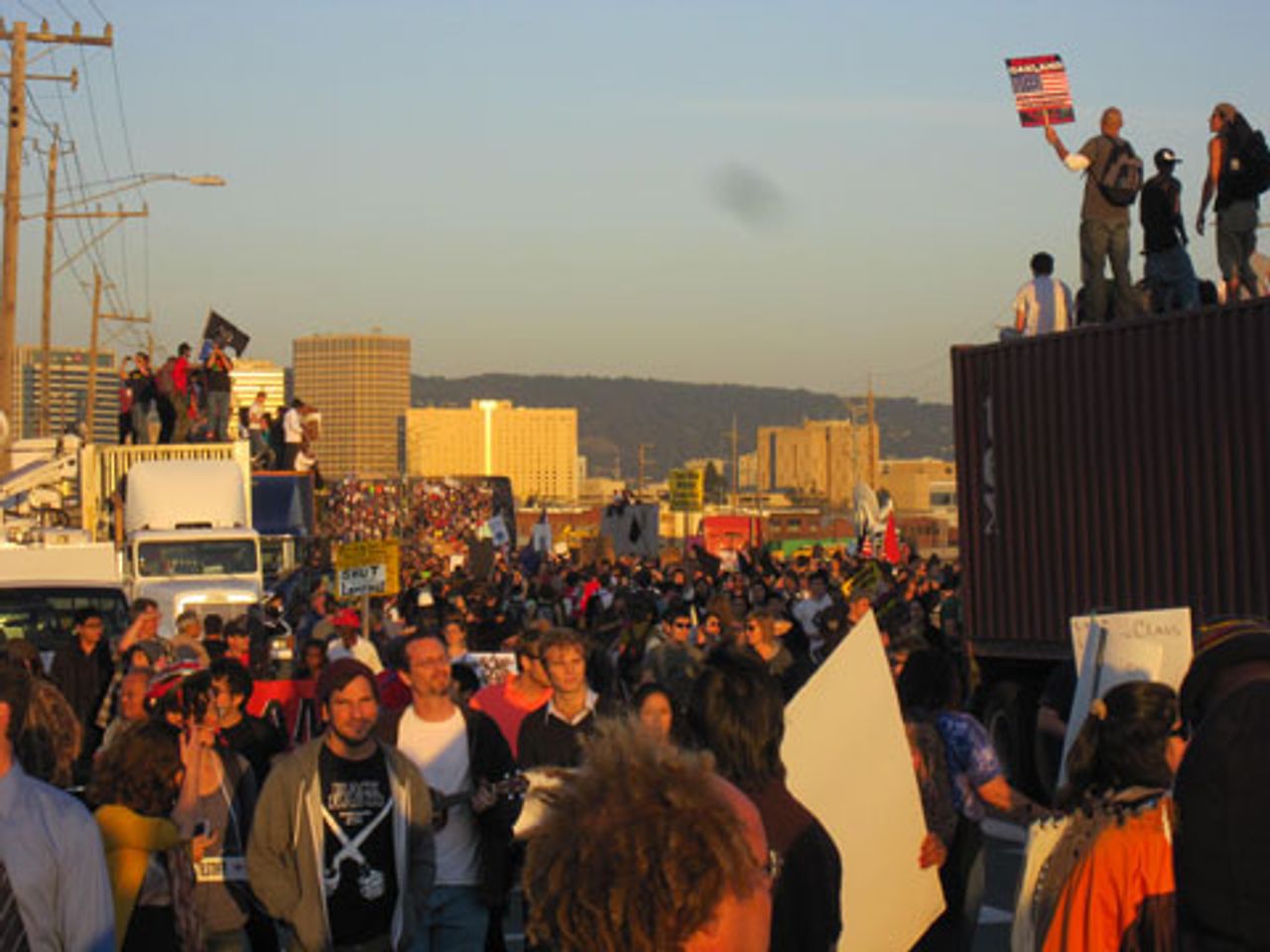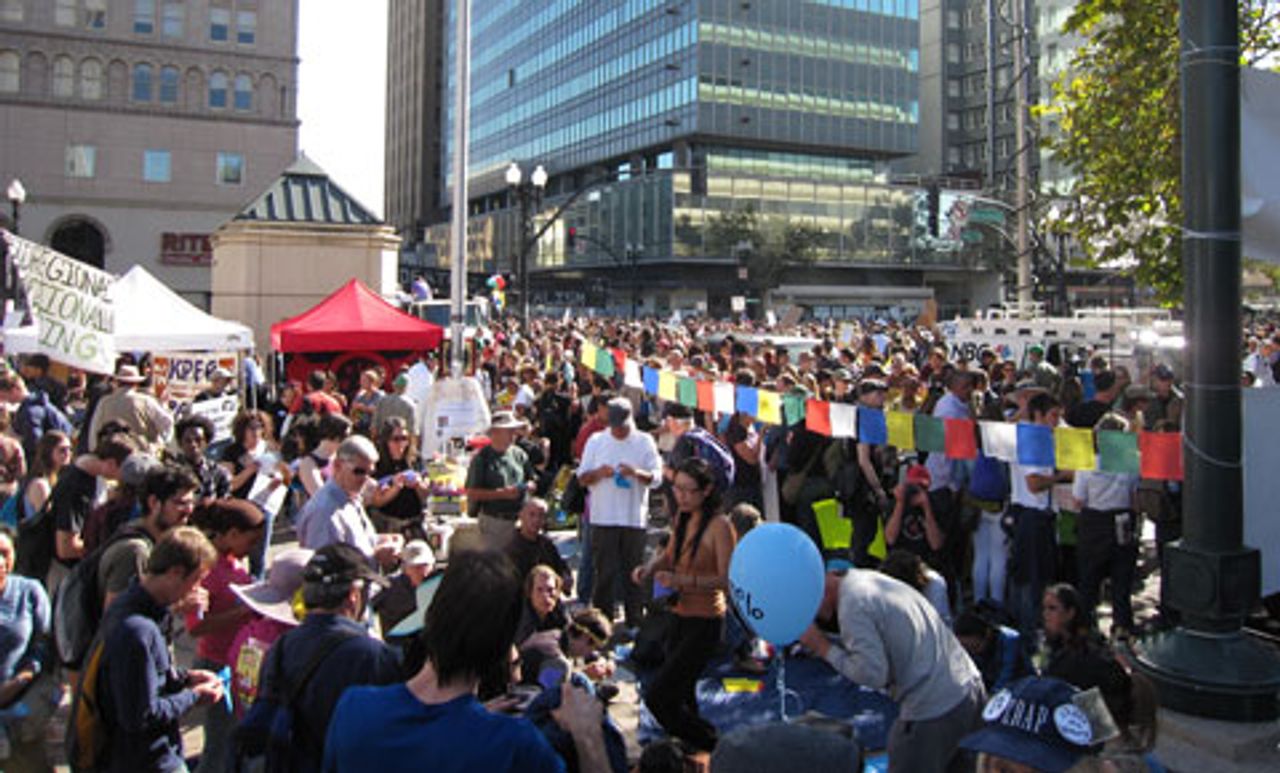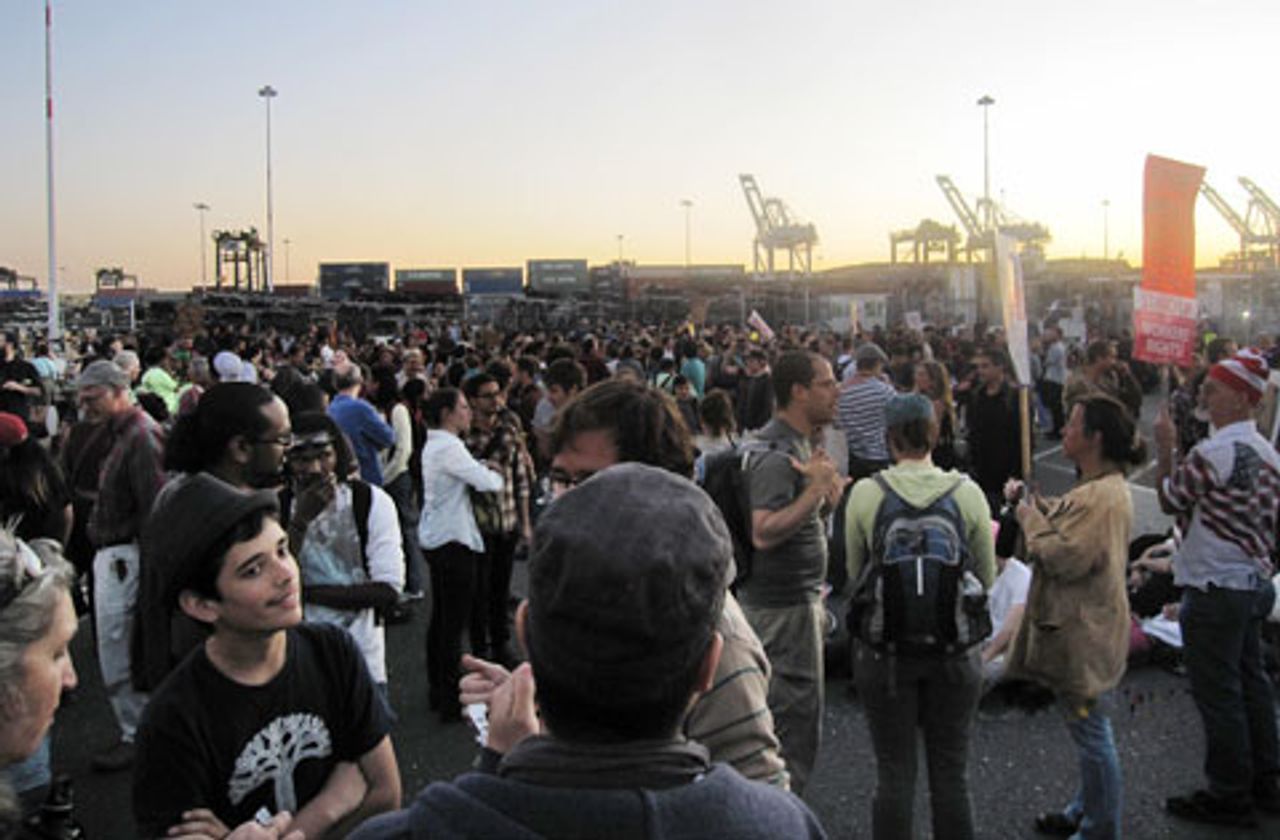Thousands march in Oakland to defend Occupy movement
By Jerry White
3 November 2011
 March arriving at Port of Oakland, stretches far into distance
March arriving at Port of Oakland, stretches far into distanceOlsen, 24, suffered a skull fracture when police fired a “non-lethal projectile” directly at his head during peaceful protests on October 25. He remains hospitalized in fair condition, according to friends.
Those participating in the protests Wednesday expressed deep outrage over the attack on freedom of speech and other democratic rights, as well as the enormous inequality that has animated the Occupy movement as a whole.
Claire, from San Francisco, told the WSWS that the police attack was “horrific.” She added, “We have the right to protest. We go into other countries and tell them to rise up, and when we do it here, we get shut down. I don’t want my kids to grow up in this ‘democracy.’”
Trixie, from Piedmont, said, “I wasn’t coming down here until I saw the attack; then I had to come. I’ve always wanted this movement to happen, and I had to come and be counted. Our government is hypocritically criticizing other government crackdowns and then doing it here.”
Referring to the 1932 attack on the Bonus Marchers during the Great Depression, she added, “It reminded me of when Eisenhower and MacArthur ordered troops to attack veterans before WWII. They killed people—they will kill to get their way.”
Meanwhile, throughout the country police repression and arrests continue. Occupy protesters were pepper-sprayed and nine were arrested in Tulsa, Oklahoma at 2 a.m. Wednesday morning after refusing to abandon their encampment. Later in the day a dozen were arrested in Philadelphia during a protest at the headquarters of cable giant Comcast.
 Crowd at edge of Oscar Grant Plaza, 14th and Broadway
Crowd at edge of Oscar Grant Plaza, 14th and BroadwayOn October 26, the day after the initial police attack, several thousand protesters gathered in a general assembly at the plaza and overwhelmingly voted for a general strike to close city businesses and services to protest the police repression.
The workers and young people who participated in Wednesday’s protests were driven by genuine opposition to the social inequality that has decimated the lives of working people. Many were there to express opposition to sharp increases in college tuition and budget cuts hitting public education and other vital programs.
It was an entirely different matter for those who are trying to tie this movement to the Democratic Party and strangle it. Fearing growing popular opposition, the Democratic administration of Mayor Jean Quan—which ordered last week’s crackdown—decided it was best to take a different tack and avoid another violent confrontation.
An indication of the attempt to give the action an official stamp of approval was the almost complete absence of the police throughout the day. This stands in sharp contrast to harsh state reaction to other protests.
The political establishment gave its blessing to the “general strike” in order to contain opposition. In a statement before the protests, Quan declared, “I am working with the police chief to make sure that the pro-99 percent activists—whose cause I support—will have the freedom to get their message across without the conflict that marred last week’s events.” In a memo last Friday, City Administrator Deanna Santana informed municipal workers that they could use vacation or other paid time off to participate in day of protest.
 The crowd at the Port of Oakland
The crowd at the Port of OaklandThe critical role, however, was left up to the trade unions and their supporters, including many of those directing the Occupy movement. Various union executives, including the head of the International Longshore and Warehouse Union (ILWU) Local 10 in Oakland, declared their support for a struggle against corporate and financial power even as they collaborate with big business and its political representatives every day of the week.
Behind the scenes, the unions assured the employers and the Quan administration that no significant disruption would take place. As a Reuters article noted, “Local labor leaders, although generally sympathetic to the Occupy movement, say their contracts prohibit them from proclaiming an official strike. City officials say government offices are scheduled to be open.” The Los Angeles Times noted “the philosophical backing of labor unions (for a general strike)” but added that most unions “have ‘no strike’ clauses but are offering general support to the Occupy Oakland action.”
A spokesman for the ILWU, Craig Merrilees, said workers will remain on the job at the Port of Oakland, but reassured everyone that the union was “encouraging members to participate before work, after work, at lunch and during breaks…”
The mayor said 200 of the city’s civilian workforce of 2,500 workers had taken advantage of floating holidays or furloughs to call in sick, while a few hundred teachers missed work. Troy Flint, a district spokesman, said teachers were allowed to take the day off if they submitted a request by Monday and the district was able to find a substitute. At the Port of Oakland, the ILWU said about 40 stevedores failed to come to work, out of about 325 expected on the morning shift.
The day’s protests culminated in a march by several thousand to the Port where trucks were blocked. While union officials and their backers hailed this stage-managed affair as “shutting down the ports” and proof of the support the unions are giving to the protests, it was in fact just another means of rendering the protest movement harmless.
The ILWU, which historically was associated with the Stalinists of the Communist Party and other political supporters of the Democratic Party, has often participated in such stunts. The aim is to give itself a left cover, even as it collaborates with the employers to cut jobs and gut the working conditions and living standards of its members.
In May 2008, the ILWU held a one-day shutdown of the West Coast ports to demand an end to the war in Iraq. It did this as part of its all-out campaign for the election of Barack Obama, who has only escalated the criminal wars carried out by US imperialism.
In its efforts to channel the protests into support for the reelection of Obama, the union apparatus enjoys the full support of middle class groups.
Typical of the outlook of these organizations was a comment on the web site of the International Socialist Organization, which sought to counter the deep suspicion of protesters towards the trade union apparatus. “[T]he unions’ involvement has raised concerns among some Occupy members, who voice fears that labor is trying to ‘co-opt’ the movement,” the ISO wrote.
Noting that AFSCME President Gerald McEntee recently said he expected activists to turn their attention to the 2012 election, the ISO declares, “But it’s wrong to conclude that unions are simply out to absorb and redirect the movement—even if they were able to do so.”
Instead, “Labor [i.e., the trade union apparatus] is responding to the groundswell of activism.” As a precedent, the ISO cites the unions’ role in the Wisconsin protests earlier this year—when the unions and the ISO helped strangle a mass movement against budget cuts by tying it to the Democratic Party!
The fight to mobilize the working class against the financial and corporate elite—and both of its political parties—can only be done through a rebellion against the official unions, which have systematically suppressed every struggle by the working class for the last three decades in order to defend American capitalism.
What is needed above all is a political struggle to free the working class from the grip of the Democratic Party and to build a mass political party of the working class whose aim is taking political power and reorganizing society along socialist lines to put an end to social inequality forever.
Thousands march in Oakland to defend Occupy movement
No comments:
Post a Comment